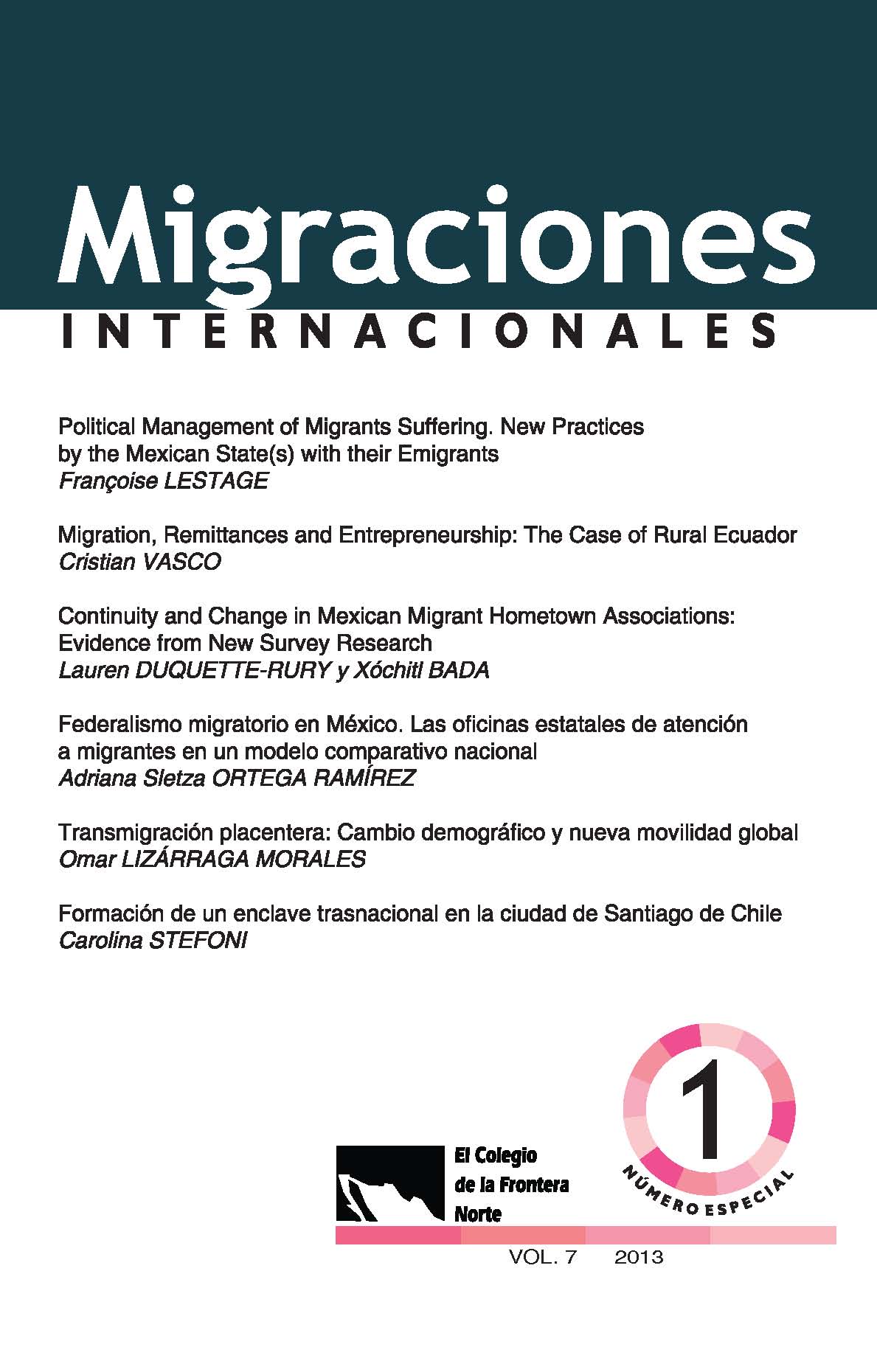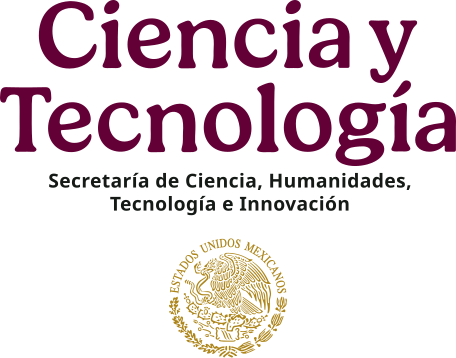Migration, Remittances and Entrepreneurship: The Case of Rural Ecuador
DOI:
https://doi.org/10.17428/rmi.v7i1.685Keywords:
international migration, remittances, rural entrepreneurship, Ecuador, South AmericaAbstract
Using data from the Living Standard Measurement Survey 2005-2006 for Ecuador, this paper analyzes the impact of migration and remittances on the likelihood of rural households owning a business.
The results show that neither migration nor remittances have any effect on the odds of a household owning a rural business. Instead, education, credit and access to services are positively correlated with the probability of owning a rural enterprise.
Contrary to expectations, empirical endogeneity tests (Smith-Blundell) fail to reject the null hypothesis of exogeneity of migration, remittances and average town remittances with respect to the likelihood of business ownership.
Migración, remesas y espíritu empresarial: El caso del Ecuador rural
Resumen
Con datos de la “Encuesta de condiciones de vida (ecv) 2005-2006”, este artículo analiza el impacto de la migración internacional y las remesas en la iniciativa emprendedora en el Ecuador rural.
Los resultados sugieren que ni la migración internacional ni las remesas afectan la probabilidad de que los hogares rurales ecuatorianos posean un negocio familiar.
En cambio, otras variables como la educación, el crédito y la disponibilidad de servicios básicos tienen un efecto positivo en la probabilidad de que un hogar rural posea un negocio. Contrariamente a lo esperado, el test Smith-Blundell no pudo rechazar la hipótesis nula de exogeneidad de la migración internacional y las remesas respecto de la probabilidad de poseer un negocio rural.
References
ADAMS, Richard H., 1991, The Effects of International Remit-
tances on Poverty. Inequality, and Development in Rural Egypt,
Washington, DC, International Food Policy Research Institute
(Research Report, no. 86).
ADAMS, Richard H., 1998, “Remittances, Income Distribution,
and Rural Asset Accumulation”, Economic Development and
Cultural Change, vol. 41, no. 1, pp. 155-173.
AMUEDO-DORANTES, Catalina, and Susan POZO, 2006, “Remittance Receipt and Business Ownership in the Dominican Republic”, The World Economy, vol. 29, no. 7, pp. 939-956.
ANTÓN, José Ignacio, 2010, “The Impact of Remittances on
Nutritional Status of Children in Ecuador”, International Migration Review, vol. 44, no. 2, pp. 269-299.
ARIF, Ghulam Mohammad, and Mohammad IRFAN, 1997,
“Return Migration and Occupational Change: The Case of
Pakistani Migrants Returned from the Middle East”, The Pakistan Development Review, vol. 36, no. 1, pp. 1-37.
BLACK, Richard, and Adriana CASTALDO, 2009, “Return
Migration and Entrepreneurship in Ghana and Côte d’Ivoire:
The Role of Capital Transfers”, Tijdschrift voor Economische en
Sociale Geografie, vol. 100, no. 1, pp. 44-58.
CALERO, Carla; Arjun S. BEDI, and Robert SPARROW, 2009,
“Remittances, Liquidity Constraints and Human Capital In-
vestments in Ecuador”, World Development, vol. 37, no. 6, pp.
-1154.
CAMACHO, Gloria, and Kattya HERNÁNDEZ, 2009, “Te-
rritorios en movimiento. Suscal: Migración y ¿desarrollo?”, in
Gloria Camacho, and Kattya Hernández, eds., Miradas transnacionales. Visiones de la migración ecuatoriana desde España y Ecuador, Quito, Ecuador, Centro de Planificación y Estudios Sociales-Secretaría Nacional del Migrante.
CANALES, Alejandro I., and Israel MONTIEL ARMAS, 2004,
“Remesas e inversión productiva en comunidades de alta migración a Estados Unidos: El Caso de Teocaltiche, Jalisco”, Migraciones Internacionales 6, vol. 2, no. 3, pp. 142-172.
CARPIO, Patricio, 1992, Entre pueblos y metrópolis: La migración
internacional en comunidades austroandinas del Ecuador, Cuenca, Ecuador, Abya-Yala.
DE HAAS, Hein, 2007, Remittances, Migration and Social Development: A Conceptual Review of the Literature (Social Policy and Development Programme Paper, no. 34).
DJAJIC, Slobodan, 1986, “International Migration, Remittances
and Welfare in a Dependent Economy”, Journal of Development Economics, vol. 21, pp. 229-234.
DURAND, Jorge, and Douglas S. MASSEY, 1992, “Mexican
Migration to the United States: A Critical Review”, Latin
American Research Review, vol. 27, no. 2, pp. 3-42.
DURAND, Jorge; Emilio A. PARRADO, and Douglas S.
MASSEY, 1996, “Migradollars and Development: A Reconsideration of the Mexican Case”, International Migration Review,
vol. 30, no. 2, pp. 423-444.
ELBERS, Chris, and Peter LANJOUW, 2001, “Intersectoral
Transfer, Growth and Inequality in Rural Ecuador”, World
Development, vol. 29, no. 3, pp. 481-496.
GRAY, Clark L., 2009, “Rural Out-Migration and Smallholder
Agriculture in the Southern Ecuadorian Andes”, Population
Environment, vol. 30, pp. 193-217.
HILDEBRANDT, Nicole, and David J. MCKENZIE, 2005,
The Effects of Migration on Child Health in Mexico, Washington, DC, The World Bank (Policy Research Working Paper, no. 3573).
HUESCA, Luis; Cuauhtémoc CALDERÓN, and Jazmín GARCÍA, 2009, “Análisis regional de las remesas y sus perceptores
en México, 2000 y 2005”, Estudios Fronterizos, vol. 10, no. 19,
pp. 49-83.
INSTITUTO NACIONAL DE ESTADÍSTICAS Y CENSOS
(INEC), 2000, Censo nacional agropecuario, Quito, inec.
INSTITUTO NACIONAL DE ESTADÍSTICAS Y CENSOS,
, Censo de población y vivienda, Quito, inec.
INSTITUTO NACIONAL DE ESTADÍSTICAS Y CENSOS, 2006, “Encuesta de condiciones de vida (ecv). Quinta ronda 2005-2006”, Quito, inec.
INTER-AMERICAN DEVELOPMENT BANK, 2003, Remit-
tance Recipients in Ecuador: A Market Research Study, Qui to, Inter-American Development Bank-Multilateral Investment Fund.
INTER-AMERICAN DEVELOPMENT BANK, 2006, Las remesas como instrumento de desarrollo, Washington, DC, Inter-
American Development Bank-Multilateral Investment Fund.
JOKISCH, Brad, 2001, “Desde Nueva York a Madrid: Tendencias de la migración ecuatoriana”, Ecuador Debate, no. 54, December, pp. 59-84.
JOKISCH, Brad, 2002, “Migration and Agricultural Change:
The Case of Smallholder Agriculture in Highland Ecuador”,
Human Ecology, vol. 30, no. 4, pp. 523-550.
JOKISCH, Brad, and Jason PRIBILSKY, 2002, “The Panic to
Leave: Economic Crisis and the ‘New Migration’ from Ecuador”, International Migration, vol. 40, no. 4, pp. 75-101.
KILIC, Talip et al., 2009, “Investing Back Home: Return Migration and Business Ownership in Albania”, Economics of Transition, vol. 17, no. 3, pp. 587-623.
LANJOUW, Peter, 1999, “Rural Nonagricultural Employment
and Poverty in Ecuador”, Economic Development and Cultural
Change, vol. 48, no. 1, pp. 91-122.
LANJOUW, Peter, and Jean O. LANJOUW, 1995, Rural Non-
farm Employment, Washington, DC (World Bank Policy Research Working Paper, no. 1463).
LÓPEZ-CÓRDOVA, Ernesto, 2006, Globalization, Migration
and Development: The Role of Mexican Migrant Remittances,
Buenos Aires, Intal/itd (Working Paper, no. 20).
LÓPEZ, Susana, and David VILLAMAR, 2004, “El proceso
emigratorio en el sur de Quito”, in F. Hidalgo, eds., Migraciones. Un juego con cartas marcadas, Quito, Abya-Yala.
LUCAS, Robert E. B., 1987, “Emigration to South Africa’s
Mines”, The American Economic Review, vol. 77, no. 3, pp.
-330.
LUCAS, Robert E. B., and Oded STARK, 1985, “Motivations
to Remit Evidence from Botswana”, The Journal of Political
Economy, vol. 93, no. 5, pp. 901-918.
MARTÍNEZ, Luciano, 2000, “La especificidad del empleo rural”, in Alicia Torres, ed., Antología de estudios rurales, Quito,
Flacso/ildis.
MARTÍNEZ, Luciano, 2004, “El campesino andino y la globalización a fines de siglo (una mirada sobre el caso ecuatoriano)”,
Revista Europea de Estudios Latinoamericanos y del Caribe, vol.
, pp. 25-39.
MASSEY, Douglas S., and Emilio A. PARRADO, 1998, “International Migration and Business Formation in Mexico”, Social
Sciences Quarterly, vol. 79, no. 1, pp. 1-20.
MASSEY, Douglas S. et al., 1987, Return to Aztlan: The Social
Process of International Migration from Western Mexico, Berkeley, University of California Press.
MCCARTHY, Nancy, et al., 2006, Assessing the Impact of Massive
Out-Migration on Agriculture, Rome, fao.
MCKENZIE, David, and Marcin J. SASIN, 2007, Migration,
Remittances, Poverty, and Human Capital: Conceptual and Empirical Challenges, Washington, DC, The World Bank.
MENDOLA, Mariapia, 2008, “Migration and Technological
Change in Rural Households: Complements or Substitutes?”,
Journal of Development Economics, vol. 85, no. 1-2, February,
pp. 150-175.
MEZA, Liliana; Carla PEDERZINI, and Sarah MARTÍNEZ,
, “El autoempleo como mecanismo de arraigo de la población en México: El caso de cuatro localidades”, Estudios Demográficos y Urbanos, vol. 21, no. 3, pp. 547-623.
MILUKA, Juna et al., 2007, The Vanishing Farms? The Impact
of International Migration on Albanian Family Farming, Washington, DC, The World Bank.
MOCHEBELELE, Motsamai T., and Alex WINTER-NELSON, 2000, “Migrant Labor and Farm Technical Eficiency in Lesotho”, World Development, vol. 28, no. 1, pp. 143-153.
PEDONE, Claudia, 2006, Estrategias migratorias y poder: Tú
siempre jalas a los tuyos, Quito, Abya-Yala.
PRIBILSKY, Jason, 2007, La chulla vida: Gender, Migration, and
the Family in Andean Ecuador and New York City, Syracuse,
United States, Syracuse University Press.
QUINN, Michael A., 2009, “Estimating the Impact of Migration and Remittances on Agricultural Technology”, The Journal of Developing Areas, vol. 43, no. 1, pp. 199-216.
RAMÍREZ GALLEGOS, Franklin, and Jacques Paul RAMÍREZ, 2005, La estampida migratoria ecuatoriana: Crisis, redes
trans nacionales y repertorios de acción migratoria, Quito, Centro
de Investigaciones.
RATHA, Dilip, 2003, “Workers’ Remittances: An Important
and Stable Source of External Development Finance”, Global
Development Finance. Striving for Stability in Development Finance, Washington, DC, The World Bank.
REICHERT, Joshua S., 1981, “The Migrant Syndrome: Seasonal
U.S. Wage Labor and Rural Development in Central Mexico”,
Human Organization, vol. 40, no. 1, pp. 56-66.
SÁNCHEZ, Betty, 2004, “El impacto de la emigración en Loja”,
in Francisco Hidalgo, ed., Migraciones. Un juego con cartas
marcadas, Quito, Ecuador, Abya-Yala.
SMITH, Richard J., and Richard W. BLUNDELL, 1986, “An
Exogeneity Test for a Simultaneous Equation Tobit Model
with an Application to Labor Supply”, Econometrica, vol. 54,
no. 3, pp. 679-685.
STARK, Oded, and David LEVHARI, 1982, “On Migration
and Risk in ldcs”, Development and Cultural Change, vol. 31,
pp. 191-196.
STARK, Oded, and David E. BLOOM, 1985, “The New Economics of Labor Migration”, American Economic Review, vol. 75, no. 2, pp. 173-178.
STUART, James, and Michael KEARNEY, 1981, Causes and Effects of Agricultural Labor Migration from the Mixteca of Oaxaca to California, La Jolla, Program in United States Mexican
Studies-University of California at San Diego.
TAYLOR, J. Edward, 1999, “The New Economics of Labour Migration and the Role of Remittances in the Migration Process”,
International Migration, vol. 37, no. 1, pp. 63-88.
TAYLOR, J. Edward, and Jorge MORA, 2006, Does Migration
Reshape Expenditures in Rural Households? Evidence from Mexico, Washington, DC, World Bank Policy Research (Working Paper, no. 03415).
TAYLOR, J. Edward et al., 1996, “International Migration and
Community Development”, Population Index, vol. 62, no. 3,
pp. 397-418.
THE WORLD BANK, 2006, Global Economic Prospects. Economic Implications of Remittances and Migration, Washington,
DC, The World Bank.
WAHBA, Jackline, and Yves ZENOU, 2009, Out of Sight, Out
of Mind: Migration, Entrepreneurship and Social Capital, Bonn,
Institute for the Study of Labor (iza Discussion Paper, no. 4541).
WOOLDRIDGE, Jeffrey M., 2002, Introductory Econometrics: A
Modern Approach, South-Western Educational Publishing.
WOUTERSE, Fleur, and J. Edward TAYLOR, 2008, “Migra-
tion and Income Diversification Evidence from Burkina Faso”,
World Development, vol. 36, no. 4, pp. 625-640.
Downloads
Published
Issue
Section
License
Authors publishing work in this journal agree to the following conditions:
Authors retain copyright and assign first publication rights to the journal Migraciones Internacionales (MI), with the texts registered under an Attribution-NonCommercial-NoDerivatives 4.0 International Creative Commons license (CC BY-NC-ND 4.0), which allows third parties to use published material provided they give credit to the authors and acknowledge this journal as the first publisher.
They authorize the reproduction, publication, translation, communication, and transmission of their paper and all accompanying material, publicly and in any form and by any means; its public distribution in as many copies as required; and public communication thereof in any form, including making it available to the public through electronic means or any other technology, and solely for dissemination and scientific, cultural, and non-commercial purposes.
Authors may enter into further independent contractual agreements for the non-exclusive distribution of the version of the paper published in this journal (for instance, to include it in an institutional repository or personal webpage, or publish it in a book), provided it is not for commercial purposes and they clearly state that the work was first published in Migraciones Internacionales (MI) [and add the corresponding bibliographical record: Author/s (Year). Title of paper. Migraciones Internacionales, volume (number), pp. doi: xxxx].
To that end, authors must submit the form assigning ownership of first publication rights, duly completed and signed. This document is to be uploaded in PDF format as a complementary file on the OJS platform.
This work is released under an Attribution-NonCommercial-NoDerivatives 4.0 International Creative Commons license (CC BY-NC-ND 4.0)..













